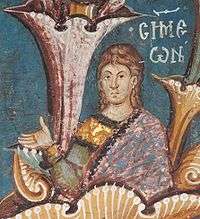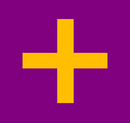Emperor of the Serbs
| Emperor of the Serbs | |
|---|---|
|
Imperial | |
|
Divellion (Emperor's personal banner) | |
|
Coronation of Emperor Dušan, in The Slavonic Epic (1926) | |
| Details | |
| First monarch | Stefan Dušan |
| Last monarch | Stefan Uroš V |
| Formation | 16 April 1346 |
| Abolition | 2/4 December 1371 |
| Appointer | Hereditary |
Between 1345 and 1371, the Serbian monarch was titled emperor (tsar), the full title being Emperor of the Serbs and Greeks (Serbian: цар Срба и Грка/car Srba i Grka) in Serbian and basileus and autokrator of Serbia and Romania ["the land of the Romans"] (Greek: βασιλεὺς καὶ αὐτοκράτωρ Σερβίας καὶ Ῥωμανίας) in Greek. The Serbian Empire was ruled by only two monarchs; Stefan Dušan (r. 1331–55) and Stefan Uroš V (r. 1355–71). Two other claimants of the title ruled in Thessaly, Central Greece.
Establishment and titulature
Taking advantage of the Byzantine civil war of 1341–1347 by alternately supporting both sides of the conflict, the Serbian king Stefan Dušan expanded his state southwards, conquering Albania and most of Macedonia by 1345, with the exception of the great fortress cities of Serres and Thessalonica.[1] This growth in power made Serbia the de facto dominant state in the Balkans, and fuelled Dušan's imperial ambitions: already in early 1343, the Serbian ruler elevated his titles to "king and autokrator of all the Serbian and Maritime Lands and čestnik of the Greek [Byzantine] Lands".[2]
Following his conquest of Serres, which crowned his conquest of Macedonia, in November or December 1345 Stefan Dušan proclaimed himself emperor (basileus), laying claim on the Byzantine imperial inheritance.[3] On 16 April 1346 hewas crowned emperor at Skopje in an assembly attended by the elevated Serbian Patriarch, and also the Bulgarian Patriarch and the Archbishop of Ohrid.[4] His imperial title was recognised by Bulgaria and various other neighbors and trading partners but not by the Byzantine Empire. Mount Athos addressed him as Emperor, though rather as Emperor of Serbs than Emperor of Serbs and Greeks.[5] In Serbian charters, ethnic terms are used – "Emperor of the Serbs and Greeks" (цар Срба и Грка).[6]
In Greek, the title was "basileus and autokratōr of Serbia and of Romania" (βασιλεὺς καὶ αὐτοκράτωρ Σερβίας καὶ Ῥωμανίας). The use of "Romania" (i.e. the land of the Romans, the Byzantine Empire) and not the usual Byzantine formula "of the Romans" was probably deliberately chosen; although in his Law Code Dušan claimed the direct succession to all Byzantine emperors from the time of Constantine the Great, he lacked possession of Constantinople and of the Ecumenical Patriarchate, which alone conferred full legitimacy to a Byzantine ruler. Notably, when the Byzantines came around to recognizing Dušan's imperial title, it was only for Serbia proper, much as they had done with the Bulgarian Tsar Simeon 400 years earlier. The contemporary Byzantine writers also clearly distinguished between the ancestral Serbian lands, where Dušan's son Stefan Uroš ruled as king, and the conquered lands "in Romania", where Dušan (and Stefan Milutin before him) continued to use the pre-existing Byzantine administration. How clear this duality was in practice is open to question, however it should be noted that—in contrast to the lionization of Dušan by modern Serbian historiography—Dušan's proclamation of empire was not well received in Serbia proper, as indicated by the fact that he was never sanctified by the Serbian Church, or why his official biography, alone among the medieval Serbian rulers, was never completed.[7]
It is interesting to note that on his early Western-style coinage, issued between his proclamation as emperor and his coronation, Dušan continued to use the abbreviated Latin title Rex Rasciae ("King of Rascia"), and simply added the title I[m]p[erator] Roma[niae] ("Emperor of Romania"), but also I[m]p[erator] Ro[ma]io[ru]m ("Emperor of the Romans"). After his coronation, the title of king was dropped.[8]
Monarchs
When Stefan Dušan died in 1355, his son Stefan Uroš V succeeded him. Uroš V's uncle Simeon Uroš in Thessaly claimed the title in rivalry, continued by his son John Uroš. With the extinction of the main line of the Nemanjić dynasty with the death of heirless Stefan Uroš V in 1371, the imperial title became obsolete. The fall of the Serbian Empire saw the state fragmenting into provinces ruled by magnates, holding various titles, except the imperial. In 1527, a renegade Hungarian-Serbian commander, Jovan Nenad, styled himself Emperor.
| Monarch | Reign | Comments |
|---|---|---|
 Stefan Dušan |
16 April 1346–20 December 1355 | |
 Stefan Uroš V |
20 December 1355–2/4 December 1371 | |
 Simeon Uroš |
1359–1370 | Rival pretender in Epirus, and later Thessaly. |
 John Uroš |
1370–1373 | Rival pretender in Thessaly. |
Titles
- Stefan Dušan
- "Emperor of Serbs and Greeks"
- "Emperor of Serbs and Greeks and the Western Provinces" (царь Срблемь и Гркωмь и Западнимь Странамь), in 1349.[9]
- "Emperor of the Serbs", by the Athonite community.[5]
- "Emperor and Autocrat of Serbia and Romania" (Greek: βασιλεὺς καὶ αὐτοκράτωρ Σερβίας καὶ Ῥωμανίας), from a chrysobull to Iveron Monastery.[14]
- "Emperor of all Serb and Greek lands, the Maritime Region, Arbania and the Western Provinces (цар свију српских и грчких земаља, Поморја, Арбаније и Западних Страна).
- "Emperor of Greece and King of All Serb Lands and the Maritime" (царь грьчкїи и краль все срьбскїе земли и поморскїе), between 1347–56.[15]
- "Emperor of Serbia and the Maritime Region" (царь србкχ и пморски), between 1347–56.[16]
- "Emperor of Rascia and Romania, Despot of Arta and Count of Vlachia" (Latin: imperator Raxie et Romanie, dispotus Lartae et Blachie comes) in 1348, after the Serb conquest of Epirus ("Arta") and Thessaly ("Vlachia").[17]
- Stefan Uroš V
- "Emperor of Serbs and Greeks"
See also
References
- ↑ Soulis 1984, pp. 10–26.
- ↑ Soulis 1984, p. 19.
- ↑ Soulis 1984, pp. 26, 29.
- ↑ Fine 1994, p. 309.
- 1 2 Fine 1994, p. 324.
- ↑ Franjo Barišić (1986). Vizantijski izvori za istoriju naroda Jugoslavije. Naučna knjiga.
- ↑ Maksimovic 2011, pp. 333–336.
- ↑ Soulis 1984, p. 30.
- 1 2 Miklošič 1858, p. 142.
- ↑ Miklošič 1858, pp. 142–145.
- ↑ Miklošič 1858, pp. 146–148.
- ↑ Miklošič 1858, pp. 149–152.
- ↑ Miklošič 1858, p. 155.
- ↑ Maffei, Paola; Varanini, Gian Maria (2014). Honos alit artes. Studi per il settantesimo compleanno di Mario Ascheri. III. Il cammino delle idee dal medioevo all’antico regime: Diritto e cultura nell’esperienza europea. Firenze University Press. p. 133. ISBN 978-88-6655-632-9.
In una crisobolla dello stesso mese Stefano concedeva privilegi al monastero di Iveron sul monte Athos in qualità di βασιλεὺς καὶ αὐτοκράτωρ Σερβίας καὶ Ῥωμανίας («imperatore e autocratore di Serbia e Romanía»)
- ↑ Miklošič 1858, p. 154.
- ↑ Miklošič 1858, pp. 154–155.
- ↑ Soulis 1963, pp. 272–273.
- ↑ Miklošič 1858, pp. 158–159.
- ↑ Miklošič 1858, pp. 165–167.
- ↑ Miklošič 1858, pp. 155–156.
- ↑ Miklošič 1858, pp. 168–169.
- ↑ Miklošič 1858, pp. 160–163, 164–165.
- ↑ Miklošič 1858, pp. 169–171.
- ↑ Miklošič 1858, pp. 172–173.
- ↑ Miklošič 1858, p. 174.
Sources
- Fine, John Van Antwerp, Jr. (1994). The Late Medieval Balkans: A Critical Survey from the Late Twelfth Century to the Ottoman Conquest. Ann Arbor: University of Michigan Press. ISBN 978-0-472-08260-5.
- Maksimovic, Ljubomir (2011). "Chapitre XVII. — La Serbie : pouvoir et administration sociale". In Laiou, Angeliki. Le monde byzantin, Tome III: L'empire grec et ses voisins (XIIIe-XVe siècle) (in French). Presses Universitaires de France. pp. 323–342. ISBN 978-2-13-052008-5.
- Miklošič, Franc (1858). Monumenta Serbica spectantia historiam Serbiae, Bosnae, Ragusii. Vienna: apud Guilelmum Braumüller.
- Soulis, George C. (1963). "Thessalian Vlachia". Zbornik Radova Vizantološkog Instituta. 8 (1): 271–273.
- Soulis, George C. (1984). The Serbs and Byzantium during the reign of Emperor Stephen Dušan (1331–1355) and his successors. Dumbarton Oaks. ISBN 0-88402-137-8.
Further reading
- Ćirković, Sima (1999). Ćirković S., Mihaljčić R., eds. "Car". Leksikon srpskog srednjeg veka. Belgrade: 789–792.
- Dinić, Mihailo (1958). "Srpska vladarska titula za vreme Carstva". Zbornik radova Vizantološkog instituta (5): 9–17.
- Marjanović-Dušanić, Smilja (1997). Vladarska ideologija Nemanjića: diplomatička studija. Srpska književna zadruga.
- Novaković, Stojan (1912). Законски споменици Српских држава средњега века. Državna štamparija Kraljevine Srbije.
- Ostrogorsky, George (1935). "Avtokrator i Samodržac: prilog za istoriju vladalačke titulature u Vizantiji i u južnih Slovena". Glas Srpske kraljevske akademije. Srpska kraljevska akademija (CLXIV): 95–187.

.jpg)